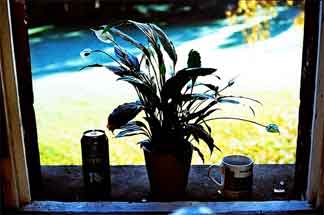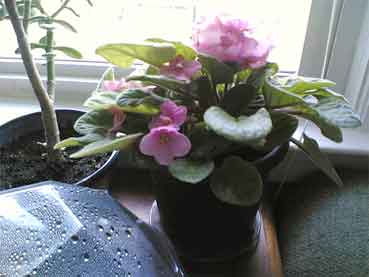A window sill of healthy house plants adds to the decor of any room, and to the enjoyment of your family and friends… this is good, but many window sills of house plants could hardly be called attractive.
Here is the all too common picture: the geraniums have shed their last leaves, the angel wing begonias followed suit, all of the gloxinia buds have blasted and the plant itself has grown into a viney sort of plant with that willowy “Dior” look. The only thing these house plants in their present state would add to is the garbage.
Your success with house plants will get no better if you discard old plants which did not survive, and add new ones, planning to give them the same care, only perhaps “more so,” in hopes of having better results. The solution to all indoor house plants and their problems comes in three words: temperature, light and HUMIDITY.

Too high temperature, not enough light and the humidity (moisture content of the air) is so low, it’s no small wonder that the plants look sick, and every member of the family (the human family, that is) has some sort of allergy, resultant from the arid atmosphere.
Plants will live in a room with high temperature, IF they have sufficient humidity. In a tiny greenhouse I placed an inexpensive humidity guide, and over a period of several months I found the humidity average was from 35 to 50%. The plants thrived there, and this is all very fine, but plants in the greenhouse added nothing to decorate the windows in a home.
Determined not to be defeated, I began to collect ideas about supplying more humidity in the home. One of my friends who has written several books on African violets told me that in her apartment the humidity average was ten per cent. Growing any sort of tropical plant with so small an amount of humidity is downright impossible. She has grouped several hundred plants together and small glasses of water are set among the plants to give a constant rise of humidity. Small, moist sponges are occasionally inserted among the pots.
How to Raise Humidity
If you do not have the space or inclination to grow several hundred plants, you may still apply this grower’s methods for supplying humidity. Group your plants together on your window sill. A shallow glass baking dish makes an excellent container for several small pots, or two large containers. Place pebbles in the bottom of the dish and keep just a little water around them.
For very small plants, seedlings, or cuttings just getting a start, group their little pots closely together in a plastic bread tray. Cover them while they are getting a start with a cover, propping it up slightly at one end with to give them air.
For a larger grouping of plants plastic trays are available which hold many plants. Friend of mine use the following method in their city apartment. Small rock is placed in the tray to a depth of an inch or so and kept constantly moist. Pots do not dry out so rapidly and the plants thrive in a room which would otherwise be void of plant growth.
For individual plants, the pot-in-pot method is good. Place your potted plant inside a larger pot, or glazed container. Pack some sphagnum moss between the two and keep this just nicely moist at all times. Try this right now on your Christmas plants… poinsettias, azaleas, and cyclamen thrive on this treatment.

For a large African violet which dominates a apartment kitchen window, use the pebble method, using an old sauce dish, try to keep just enough water in the dish to reach the top of the pebbles, but not to a depth that would submerge the pot bottom.
If you have a room full of plants, a vaporizer will work wonders if run for at least an hour every day. Use plain water to fill the vaporizer. If you have tiny plants, especially something rare, or that you treasure highly, and you simply cannot get them to grow in the open, try growing them in a terrarium. A discarded fish bowl will serve the purpose.
Meet Light Conditions
Light problems may often be solved by choosing wisely the plants you try to grow. An east window may harbor such plants as the African violet, gloxinias, begonias, impatiens, and a variety of other plants. The south window offers an ideal spot for winter blooming geraniums, amaryllis, rich-leaved coleus, semperflorens begonias, gloxinias, oxalis, and here a cactus or succulent collection should prove to be a successful venture.
West windows are excellent for most sun loving plants including those mentioned for a south window.
The north window provides a home for Rex begonias, small cuttings being rooted, seedlings, and certain foliage plants. Episcias, striking members of the gesneriad family to which African violets and gloxinias also belong, often do well in a north window… especially in southern states where lack of sunlight is no wintertime problem.
A real foliage beauty is Hoffmannia refulgens, highly adaptable to the north window. Maidenhair fern, Adiantam caneatum, is an outstanding north window plant, provided it has humidity.
Lack of humidity even plagues greenhouse growers. We built a greenhouse so we could spray water all over the walk and under the benches. Years ago a friend of mine in Oklahoma had humidity difficulties in her small conservatory which she finally solved by setting plastic bottles of water along the shelves of the lean-to structure. Evaporation from the bottles benefited plant growth, and when she wanted to water her plants, room temperature water sat at her finger tips.
